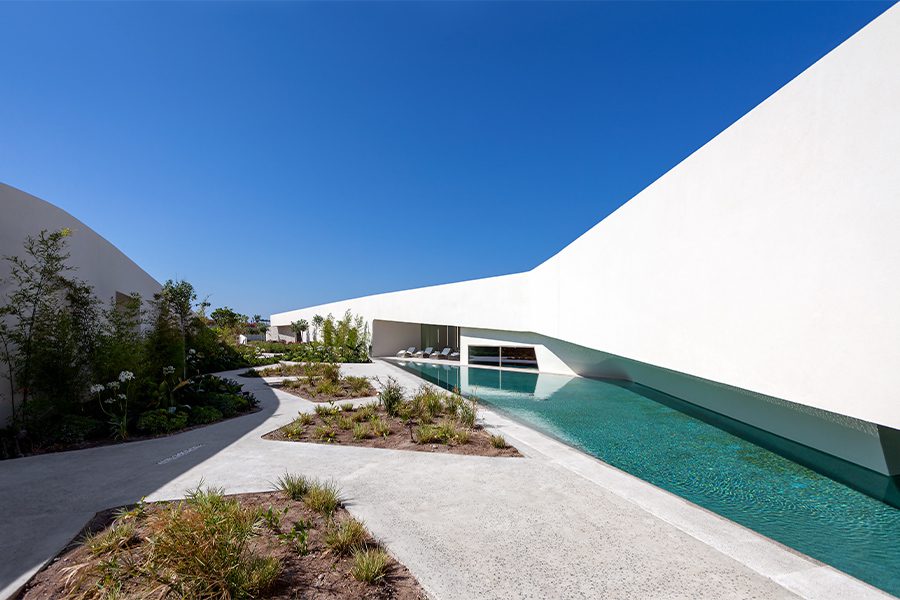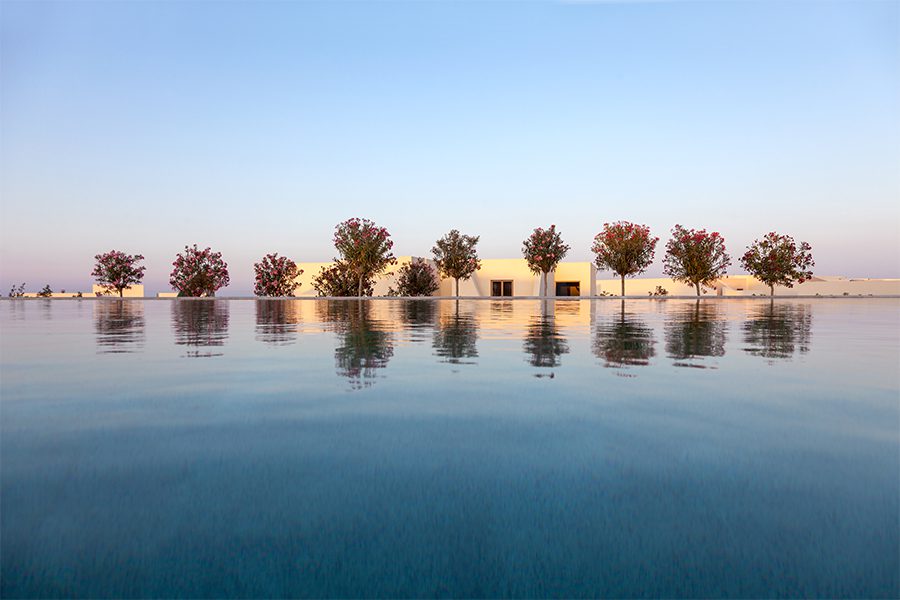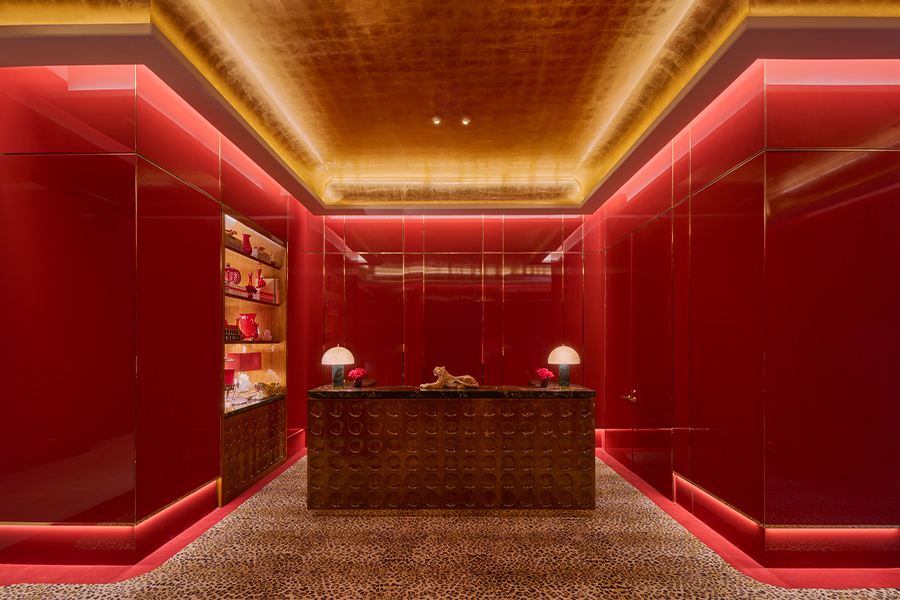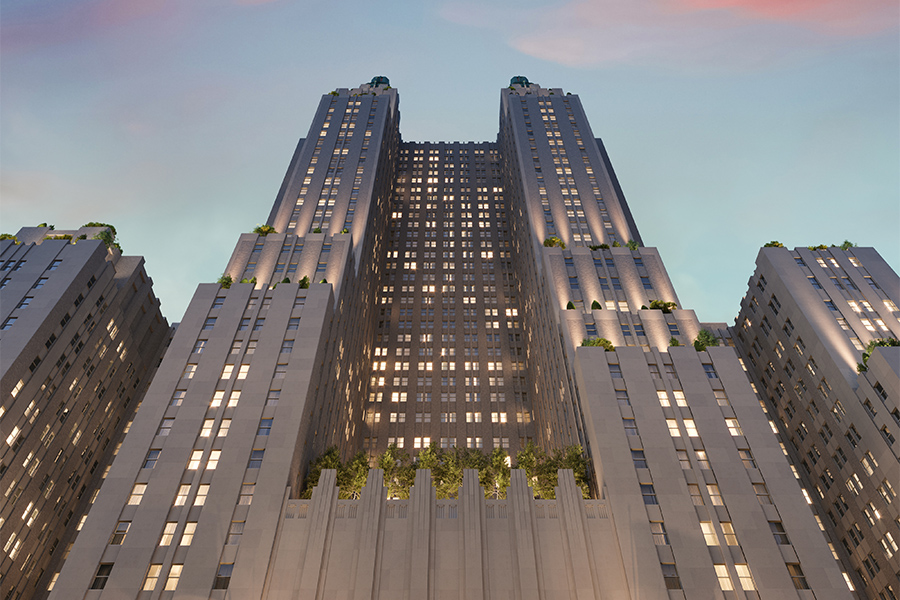Santorini is one of Greece’s most famous and romantic islands, known for its Cycladic architecture—some topped with blue domes—and its active volcano. The latter served as the muse for Noūs Santorini, the idyllic 121-room resort designed by London- and Athens-based Divercity Architects and Athens firm MPlusM Architects.
MPlusM founding partner Memos Filippidis and Nikolas Travasaros, founding partner and director of Divercity Architects, are longtime friends who previously worked together on the Grace Santorini hotel and have been partnered on this resort since 2010. (The project was put on hold during the Greek financial crisis.) Those 12-plus years were spent revising plans and perfecting the concept, with the duo aiming to reinterpret Santorini’s signature whitewashed aesthetic into a modern hotel.
A renovation of an existing structure along with an adjacent expansion with new buildings, the nearly 108,000-square-foot resort is one of the largest on the island and comprises a restaurant, retail spaces, a vitamin and health bar, and a wellness center. “We had to completely strip down the concrete frame and rebuild it while connecting it with the new part,” says Travasaros. “It was difficult in the sense that we had to integrate an existing resort into something new.”

Composed of two linear buildings, the wellness center is characterized by its sinuous curves that unfold into the landscape, simulating the natural ravines dug into the soil
To create a holistic design, the firms turned to the rugged landscape for inspiration. As guests move through the property, it feels as if they are walking through a Greek island village. Yet, the bright and airy spaces take on a mysterious quality that nods to the island’s volcano. “Everybody is always looking toward the blackness of the volcano,” Filippidis points out, “and we tried to replicate that in the hotel.”
Informed by Santorini’s geology with shades of graphite and black blending with earthy red, ochre, and brown hues, the interiors embrace the volcanic colors while still employing the serenity of Santorini’s crisp tones. “It’s something quite new for a hotel of this type in Greece,” Travasaros says. The inviting palette mixes terrazzo with fragmented colored marbles that create playful flooring in the restaurant, bar, and staircases. Guestrooms, too, have an overlay of terrazzo, with lighting made of volcanic stone and clad in smoke-treated timber.

Nods to Santorini’s active volcano appear in the reception area, with a charred wood back wall, while teal furnishings reference the shades of the island
Among the new buildings is the wellness center, which provides a moment of tranquility and reflection. Made of two linear buildings—the longest at the resort—the structures boast sinuous curves and low profiles that nearly disappear into the landscape. Enveloped by a ravine replete with greenery, it calls to mind a secret garden of sorts that celebrates “the relationship between landscape and architecture,” Travasaros says. Given its location, the sun reflects off the building, creating an interplay of light and shadow that is “one of the [resort’s] most beautiful moments,” Filippidis says. Inside, guests are guided by the curving, earthy red-hued walls as they meander through a series of volumes in the hammam and sauna. When they finally glimpse the blue water of the indoor-outdoor pool, “it’s a magical moment,” he adds. “It’s not a typical building, it exemplifies [the idea of wellbeing].”
Indeed, Noūs Santorini is an escape, a separate world altogether. As guests ascend the staircase that leads to the entrance, they hear the water as it trickles down the steps. “You are introduced to a different atmosphere,” Travasaros says. “By emphasizing so much of the landscape, we’ve created an interesting environment.”
This article originally appeared in HD’s October 2022 issue.










